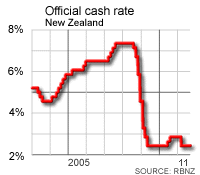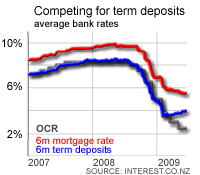 The Reserve Bank has left the Official Cash Rate on hold at 2.5%, arguing there are initial signs emerging of a recovery in both the global economy and the New Zealand economy. (Updated to include full RBNZ statement, Twitter Feed from post OCR news conference, Twitter feed from Bollard appearance at Finance and Expenditure Committee hearing)
An unexpected rebound in activity in the housing market from March through to May indicated consumer spending could be stronger than forecast, but the Reserve Bank said this was unsustainable given a likely rise in unemployment and still-high debt levels.
Governor Alan Bollard said any economic recovery was likely to be slow and fragile. The Reserve Bank said it may yet have to cut the Official Cash Rate again, but only modestly. It reiterated its assurance that it would keep the OCR at or below the current level through until the latter part of 2010.
The Reserve Bank reduced its forecast for the fall in house prices from the peak to 13% from 19% in its March quarter Monetary Policy Statement.
The Reserve Bank has left the Official Cash Rate on hold at 2.5%, arguing there are initial signs emerging of a recovery in both the global economy and the New Zealand economy. (Updated to include full RBNZ statement, Twitter Feed from post OCR news conference, Twitter feed from Bollard appearance at Finance and Expenditure Committee hearing)
An unexpected rebound in activity in the housing market from March through to May indicated consumer spending could be stronger than forecast, but the Reserve Bank said this was unsustainable given a likely rise in unemployment and still-high debt levels.
Governor Alan Bollard said any economic recovery was likely to be slow and fragile. The Reserve Bank said it may yet have to cut the Official Cash Rate again, but only modestly. It reiterated its assurance that it would keep the OCR at or below the current level through until the latter part of 2010.
The Reserve Bank reduced its forecast for the fall in house prices from the peak to 13% from 19% in its March quarter Monetary Policy Statement.
 It also warned the rise in the New Zealand dollar created an unhelpful tension with its forecasts and that there was room for banks to lower their short term lending rates.
The decision to leave the OCR on hold at 2.5% was in line with most local bank economist forecasts, although some saw a chance the Reserve Bank would cut a further 25 basis points to 2.25%.
We will be bringing you further analysis and commentary throughout the day.
Here is the full press statement from the Reserve Bank below.
It also warned the rise in the New Zealand dollar created an unhelpful tension with its forecasts and that there was room for banks to lower their short term lending rates.
The decision to leave the OCR on hold at 2.5% was in line with most local bank economist forecasts, although some saw a chance the Reserve Bank would cut a further 25 basis points to 2.25%.
We will be bringing you further analysis and commentary throughout the day.
Here is the full press statement from the Reserve Bank below.
The Official Cash Rate (OCR) will remain unchanged at 2.50 percent. Reserve Bank Governor Alan Bollard said: "The economic outlook remains weak both in New Zealand and in other countries. However, there are signs that international economic activity is stabilising, and international financial conditions are improving. We expect the New Zealand economy to begin growing again toward the end of this year but the recovery is likely to be slow and fragile. Many key economic indicators such as unemployment are projected to keep deteriorating well into 2010. "There remain some material downside risks to activity and inflation, but for the first time in some months we can also identify some clear upside opportunities for activity. One such area is a potential rebound in household spending and residential investment as a result of the rise in net immigration and the pick-up in the housing market. Ultimately, however, we do not think such a rebound in spending would prove sustainable given the soft outlook for employment, wages and farm incomes and high levels of household debt. "On balance, the risks to activity remain weighted to the downside. "The recent rise in the New Zealand dollar creates an unhelpful tension with our projections. A stronger dollar at a time of weak global growth risks delaying or even reversing the projected increase in exports, putting the sustainability of recovery at risk. "Overall, recent developments point to lower inflationary pressure than previously projected. Annual CPI inflation is likely to fall temporarily below the bottom of the target band later this year, but we expect it to return to inside the band by early 2010 and remain comfortably there over the remainder of the projection. "We have cut the OCR by a large amount over the year. We expect the effects to pass through to more borrowers over coming quarters as existing fixed-rate mortgages come up for re-pricing. Although rising longer-term interest rates overseas are placing upward pressure on longer-term lending rates here, there is room for further reductions in shorter-term lending rates. "The low OCR and stimulatory fiscal policy are the main sources of support to the New Zealand economy at present. It is likely to be some time before the recovery becomes self-sustaining and monetary policy support can be withdrawn. "We therefore consider it appropriate to continue to provide substantial monetary policy stimulus to the economy. The OCR could still move modestly lower over the coming quarters. As we said at the time of the April OCR decision, we expect to keep the OCR at or below the current level through until the latter part of 2010."Here is the link to the full Monetary Policy Statement on the Reserve Bank website. Click here to see the press conference held at the Reserve Bank on Thursday morning. Here's a live Twitter Feed including tweets from the Reserve Bank news conference after the decision to hold the OCR at 2.5%.

We welcome your comments below. If you are not already registered, please register to comment
Remember we welcome robust, respectful and insightful debate. We don't welcome abusive or defamatory comments and will de-register those repeatedly making such comments. Our current comment policy is here.